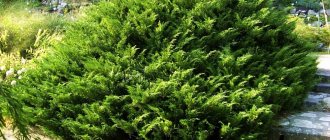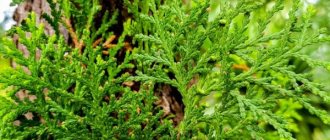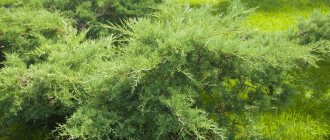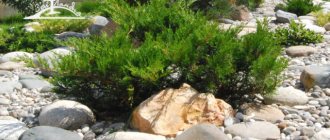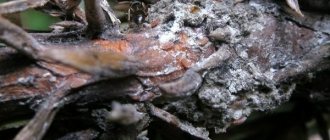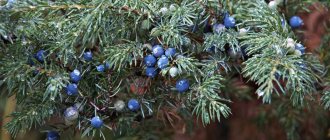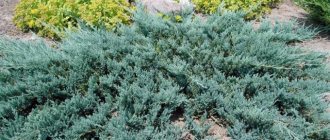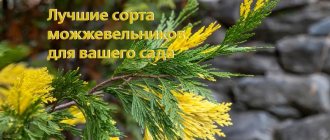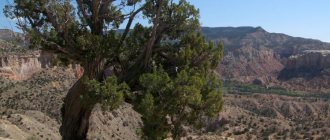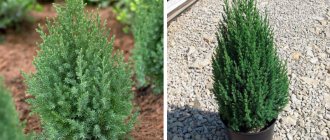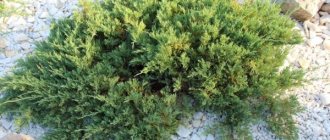Rock juniper: description and characteristics
Rocky juniper in landscape design: photo
Rock juniper is presented as a shrub or dioecious tree. The height of the tree can reach 18 meters. The diameter of the trunk does not exceed two meters. Juniper grown in gardens does not reach such height and diameter.
The crown initially has an irregularly formed conical shape. And later it becomes rounded, starting near the base. The barrel is painted brown. The shoots have pale blue or greenish-blue shades. The leaves are located opposite each other. They have a rhombus shape. They are about 20 mm long and 10 mm wide. The leaves can be dark green, green-gray. And also blue with a hint of grey.
The plant is covered with needle-like needles no more than one and a half centimeters long and no more than 20 mm wide. The shape of the cones is spherical. They are dark blue in color with a slight hint of blue. They are about 60 mm long. The ripening of cones occurs only after two years. The seeds are ribbed brown with a shade of red and 50 mm in diameter, located inside.
Popular decorative types
Juniper is an indispensable plant for garden decoration; many species of this unique crop have excellent decorative abilities, making them popular among landscape designers. Types of juniper growing in uncharacteristic conditions include:
- Rock juniper is a tree distinguished by its unusual scaly blue needles. It easily overcomes drought, but with difficulty overcomes cold windy weather.
- Chinese juniper is an ornamental plant that can be classified as a slow-growing crop. It surprises with its richness of varieties. It may appear as a tall tree or as a shrub. It is demanding about the quality of the soil; it must be fertile. It is used to decorate the natural topography of the site.
- Juniper horizontalis is a shrub belonging to the creeping group. It is distinguished by creeping branches of needle-shaped needles that cover the ground, decorates the territory with an unusual shape, and demonstrates the excellent color of fresh greenery. It is found in nature on hills; coastal lands are favorable for it.
Rock juniper: planting and care
Rocky juniper in landscape design: photo
By purchasing rock juniper, which has a closed root system, you can plant it within 9 months. Except in winter. If you purchase seedlings with an open root system, then they must be planted during the growing period. When the earth has already warmed up, but the movement of juices has not yet begun. Caring for a plant is very simple if you are familiar with some rules and follow them.
Juniper prefers to grow in open sunny areas where groundwater is located underground at great depths. For dwarf varieties, as a rule, you need to choose poor soil. Otherwise, they will grow larger than their typical size.
Tall varieties, on the contrary, need soil saturated with nutrients. When planting, it is important to consider that the plant loves large spaces. The hole for it must be made twice as large as the earthen ball on the root system. And the distance between them must be kept at 2 meters. Because after 10 years, plants begin to actively grow. Accordingly, more space will be required.
Rock juniper. How to plant?
When planting dwarf varieties, you must maintain a distance of 50 centimeters, no less.
Having made a hole of the required size, you need to put crushed stone or broken brick at the bottom. This is necessary to create a drainage layer that will prevent excess water from stagnating. A few hours before planting the plant in open ground, the container along with the seedling is immersed in water. This method will allow you to avoid damaging the roots when removing it from the container. By keeping a ball of soil on the roots when planting, you will help the plant quickly adapt to new conditions. And also begin to develop.
Before planting, the hole must be filled in advance with a soil mixture, which will include peat, turf soil and sand in proportions of 2 x 1 x 1.
After the plant is planted, it is important to water it abundantly. After waiting for the water to be absorbed, you need to mulch. For this you can use sawdust and pine bark. And also peat. It is necessary to cover the soil around the trunk with a layer of 80 centimeters. Make sure that the root collar remains at ground level when planting.
Rocky juniper: care rules
Rocky juniper in landscape design: photo
Rock juniper is a low-maintenance plant. Therefore, doing this will not be difficult at all. This plant is unpretentious. And it will feel comfortable even in urban conditions. It is important to remember that it will begin to grow actively only after 10 years.
Caring for adult plants includes watering. And even then, as a rule, only during periods of prolonged drought. And no more than three times during the season. As for young, newly planted seedlings, watering is done more often. It is also sprayed with water at room temperature in the evening.
In addition to watering, juniper needs only one feeding. It is carried out at a young age in mid or late spring. Organic fertilizers cannot be used for fertilizing. Nitroammofosk will be an excellent solution. It is used in proportions of 40 grams per 1 sq. meter.
Not all varieties need attention in winter. If the plant's crown looks like a column, then it will be necessary to shake off the snow from it in case of heavy snowfalls. Because a large layer of snow can break branches with its weight. You can also use twine to avoid injury. They use it to pull all the branches, pressing them to the trunk.
Which juniper is suitable for an alpine slide?
Dwarf, creeping and creeping varieties of the crop are ideal for alpine hills. Compact plants will contrast effectively with taller thujas and spruce trees. If you want to create compositions exclusively from juniper, then you can use pyramidal types. They are planted singly or in small groups. Creeping varieties can be placed nearby, but so that there is enough space between them, since their root system is highly branched.
Read more about how to grow juniper at home.
Shrub transplantation
Rocky juniper: photo
When replanting rock juniper, it is important to follow the rules so that the plant does not subsequently die. The cause may be severe damage to the root system during the work. It is especially difficult for mature and large bushes to tolerate replanting. Therefore, it is better to immediately choose a suitable place for them. There are several rules that allow you to do this without harming the plant. One of the most important rules for preserving roots is digging while preserving a complete earthen clod.
It is better to transplant from March to April. And also from June to July. Because during these months maximum root formation occurs. However, it should be noted that experienced gardeners prefer the spring months rather than the summer months. Considering that during the hot period more water evaporates from the needles. And without it, the plant weakens and the adaptation period occurs more slowly. If it was not possible to replant in the spring, but time is pressing, then this can be done in the autumn when the leaves fall.
Before planting, prepare a planting hole of the required size in advance. The size should take into account the size of the earthen ball on the roots. Next, a drainage layer of 20 centimeters is laid on the bottom. You also need to prepare a soil mixture that will fill the planting hole. You can remove the bush from its old place of residence after everything is prepared. To do this safely, you need to dig up the bush at a distance of 50 or a little more centimeters from the trunk. Next, remove the bush along with the earthen lump. Place it on any fabric and carefully move it to a new place.
Planting a bush follows the same principle as planting seedlings. After planting, mulching is carried out around the trunk. It is important to know that direct sunlight is dangerous for a transplanted plant. Therefore, it must be protected from them.
Winter care
During heavy snowfall, the crowns of tree-like varieties of juniper may fall off (disintegrate). Therefore, in the fall, gardeners tie the crowns of trees in advance.
At the end of winter, beginning of spring, some species may be exposed to active sunlight. Consequently, at the end of February and beginning of March, the branches need a fabric cover or canopy. The buds of an older conifer remain alive after sunburn or frost. The shoots of a young plant, growing back, hide the damaged areas. If the buds have suffered from severe frosts or direct sunlight, the plant will not “hide” them. In this case, human help will be required: cut off the bad branches to healthy places and treat them with special means.
Juniper in winter
Types of juniper shelter for the winter:
- Snow. A light coat of snow is suitable for dwarf and creeping species. To avoid the death of the plant during heavy snowfall, it is recommended to make a protective frame, otherwise the plant will die.
- Lapnik. These are branches of coniferous trees, mainly spruce, that cover juniper.
- Burlap, paper, light cotton fabric - all this can be used to cover the juniper and tie it with a rope, while leaving the lower part of the crown open. It is forbidden to use film; it will not allow the plant to “breathe” and it will disappear.
Juniper transforms the landscape. It is noteworthy that the coniferous plant takes the desired shape with the help of a haircut. Do you want to have the geometric shapes of a Scandinavian garden or the creeping shrubs of a Japanese garden? Then plant juniper, which will reward you with its healing aroma and decorative appearance.
Rock juniper: diseases
Juniper is susceptible to a disease called rust. This is a fungal disease that occurs due to stagnation of water in the soil. The disease can be identified by bright orange growths. They contain oils whose composition is similar to carotene. Within a short time, the bush, which has not escaped this disease, loses its charm. Because its branches are rapidly drying out. A few years later he dies.
You can save the plant. The main thing is to detect the disease in time. And also start treatment immediately. First of all, it is necessary to cut off and burn all areas affected by the disease. Next, the bush is treated with fungicides. You can choose medications in any specialized store. And also in the nursery, after consulting with the seller.
Juniper is often affected by a disease such as fusarium. This fungal disease occurs due to excessively dense soil. And also increased moisture in it. The disease affects the roots. As a result, nutrients are no longer transferred to the entire plant. This is due to the fact that fungi settle in the vascular system of the juniper. The presence of the disease can be determined by drying apical shoots. The needles change color to pale red.
The disease then spreads throughout the plant. It is very difficult to notice damage by fusarium at the first stage. But if you still see the tops starting to change color, cut them off as quickly as possible. And treat the entire bush, including the surface of the soil around it, with a fungicide. It would be best to replace the surface layer of soil with a new soil mixture impregnated with a fungicide.
Planting juniper with flowers in a summer cottage
Conifers look stylish and impressive in combination with flowers. All kinds of flower beds are created from them. Ideal neighbors are bulbous crops. But it is better not to choose crops with large and lush inflorescences, since both types of plants will get lost against each other. There is no need to plant roses, peonies, and clematis close to junipers; they will not develop well. They should be separated by 1-2 m.
Did you know? Previously, peasants, before starting to pickle cucumbers in a barrel, rubbed the inside of the tub with juniper branches. This technique prevented the development of putrefactive processes.
Roses and junipers
Roses and juniper may well coexist, but only if they grow over a large area. Both crops have a very branched root system, and to prevent it from intertwining, there must be at least one and a half meters of free space between them.
These plants respond to sunlight slightly differently. Therefore, if you use them in one composition, then for juniper it is better to choose a slightly shaded place, and for roses - a sunny and most visible area. The flower loses its sophistication if it grows in the shade.
Juniper and hydrangea
Coniferous plants look great next to deciduous ones. Ideal partners would be juniper and hydrangea. You can choose any variety of coniferous plants: dwarf, tall. It all depends on what you prefer to make the background, coniferous or deciduous bush.
The flowerbed created in this way is expressive.
The main thing is to take into account the size of adult plants when preparing a planting site, so that when they grow, they do not crowd each other, or regularly monitor their growth. By arranging dreamy hydrangea and common juniper, you can create chic hedges.
How to fight diseases?
As a preventive action, purchased planting material. And also the earthen lump must be treated with fungicidal preparations. The root system of small seedlings should be placed in the solution for 2-3 hours.
Another disease that can destroy juniper is drying out. It is possible to determine that a plant has been affected by this type of fungal disease in the spring. The bush begins to turn yellow and gradually dies. As the disease progresses, small fungi may be seen on the bark. If this disease is detected, treatment should be started immediately. First of all, branches with yellowed needles are cut off. And then the plant is completely treated with a fungicide. If it was not possible to detect the disease in time and the entire plant turned yellow, then the bush should be removed and burned. As a preventive action, it is necessary to spray the bushes in mid-spring and mid-autumn with solutions special for this purpose.
Brown schutte is another disease that can be encountered when growing juniper. You can recognize it by the falling needles, colored yellow. As a rule, signs of the disease begin to appear at the beginning of the first summer month. By the end of the last summer month, the plant is covered with black mushrooms. By choosing the right place for planting, properly watering and caring for it, this disease can be completely avoided. If this could not be avoided, then when the first signs appear, the yellow needles are cut off. All fallen pine needles are also collected and burned. Next, the entire plant is treated with a fungicide. Prevention is carried out using these solutions in the second month of spring. And also before the onset of frost.
Correct application of fertilizer
In our area, junipers are resistant to many diseases and do not require special feeding or spraying. It will be enough to water in dry times and “feed” with nitrogen and complex fertilizers several times a season.
Fertilizing coniferous trees with animal humus is strictly prohibited.
This “fertilizer” causes the juniper roots to burn and the plant dies. The nutrition of the trunk will deteriorate and the plant will begin to dry out if you loosen the soil around the plant. For juniper, it is enough to mulch (cover) the soil with coniferous soil, which was previously collected in a pine forest.
You can maintain the brightness and richness of the color of the plant by regular watering (do not overwater) and fertilizing with microfertilizers in early spring and late summer.
Insect pests
Among the harmful insects that attack juniper, you can encounter aphids, scale insects, and spider mites. And also mining moths. Fitoverm solution will help to cope with aphids. Using it, the entire bush is sprayed. When using, you must follow the instructions on the package.
Moths can be dealt with using Decis solution in the proportions specified in the instructions. To get rid of scale insects, dilute 70 grams of Karbofos in one bucket of water. And use it to cultivate the bush and the ground around it.
Spider mites can be controlled with acaricides.
Diseases and pests: treatment methods
Junipers are susceptible to diseases, especially fungi. More often than others, ocher growths can be found on branches, indicating rust infection. This parasite requires two hosts, one of which is a pear, apple, rowan or hawthorn. You can avoid infection by planting the conifer as far as possible from another host. All affected branches must be removed with a sterile pruner and the instrument must be disinfected again after work. Without waiting for autumn, juniper and pear need to be treated with Topaz 2 times a month.
High soil moisture can cause a disease such as Brown Schutte. It looks like a gray, almost black cobweb that has enveloped the entire bush. Young shoots die, then the entire plant may die. Severely affected branches are removed and the entire plant is treated with Bordeaux mixture.
To avoid infection of plants with fusarium, they are treated with Bactofite before planting. If the plant is already infected, it can be watered with a solution of Fundazol.
Insects infect junipers less frequently, but scale insects or spider mites can still be found on their branches. The plant must be treated with Aktara, Fufa-nova or Fitoverm.
Trimming
Juniper does not require formative pruning. Because the shape of its crown is naturally very impressive. It only needs sanitary pruning. Pruning is carried out in the spring. Before the start of sap flow. It should be done on rainy or cloudy days. Sanitary pruning includes the removal of all dried, injured, disease- or pest-damaged stems and branches. It is also necessary to remove those that grow incorrectly.
If you need to trim the crown, you should remember that during the year the bush grows no more than 10 centimeters. Therefore, cutting branches should not exceed 20 mm.
Junipers in landscape design - styles and combinations
Juniper, thanks to the severity of its forms, fits well into styles that are characterized by geometry, spaciousness and naturalness.
- Japanese. In the Japanese style, they adhere to a certain arrangement of stones. Plants chosen are low and not flowering. Most juniper species do not flower, so the choice is not limited to just one or two species.
- English. The aristocracy of the British is visible in the style of parks and gardens: against the backdrop of a neat lawn of moss, heather, and lichen, larger species of juniper look majestic. In such a park or garden, the emphasis is on coniferous plants with bright colors.
- French. The basis of this style is the use of evergreen plants of geometric shapes and their symmetrical arrangement on the territory.
Whatever style you adhere to in the design of your personal plot, you must remember that tree-like junipers additionally strengthen the slopes of the terraces, and ground cover and ball-shaped ones hide the unevenness of the site.
Varieties of juniper (video)
How to propagate rock juniper?
Reproduction of rock juniper occurs through layering and cuttings. And also through vaccinations. If you decide to propagate the plant through cuttings, then in the spring you need to prepare cuttings. To do this, not completely woody branches with a small piece of wood are cut off. The cuttings are planted in the greenhouse until they are completely rooted. Next, they are planted temporarily in a small bed. The period during which rooting occurs can be from one and a half to six months. It depends on the age and variety. Growing up takes place from 3 to 6 years in a place specially designed for this.
Only those varieties that have creeping forms can be propagated using layering. In this case, the young stem is cleared of needles, bends to the ground and is fixed. The soil where the young shoot will be directed must be cleared of debris and weeds in advance. Rooting of cuttings occurs in the interval from 6 months to 1 year. Next, they need to be separated from their parent. And transplant it into a temporary bed, which should be located in the shade.
To propagate rock juniper using grafting, you will need knowledge. And also the skills of a professional. It will be extremely difficult for an amateur gardener to do this.
Main features of Blue Arrow juniper
The plant belongs to the Cypress family and its natural habitat is limited to some areas of Canada, the USA and northern Mexico, most often it can be found on rocky soils and mountain slopes.
The crown of the shrub is formed at the very base of a narrow trunk covered with brown bark; young shoots are distinguished by their light color, giving the plant an unusual appearance, which allows it to be cultivated for further use in the transformation of summer cottages, garden plots, and local areas.
Origin of rock juniper and its varieties
American breeders have done a lot of work, thanks to which there are currently many different varieties of rock juniper in the world. All of them are very popular among gardeners in all corners of the earth in which their cultivation is possible.
Rocky juniper in landscape design: photo
- Blue Arrow - The height of the bushes of this variety reaches 2.5 meters. Its crown has the shape of a column 50 centimeters wide. The branches are covered with scaly needles that resemble needles. It also has a greenish-blue color with a hint of steel.
- Blue Haven - The plant can grow up to 2 meters in height. The crown is in the shape of a pyramid, no more than 1 meter wide. The needles are light blue in color and have a steel tint.
- Skyrocket - This variety is capable of reaching 6 meters in height. It is highly resistant to winter cold. The stems are covered with needles, like green scales. They fit tightly to the trunk, which makes the plant very narrow and graceful. The variety has low resistance to fungal diseases.
- Moffat Blue - This variety can reach 6 meters in height. It is highly resistant to winter cold. Its dense crown resembles a pyramid about 1.3 meters wide. The needles are colored green with a blue tint. Not suitable for growing in regions with high humidity.
- Moonglow - This variety has similar characteristics to Blue Haven. It has a crown in the shape of a wide pyramid. The height of the plant reaches no more than 2.5 meters. Width no more than 1 meter. The needles are painted in bright shades of blue with a silver tint. Colors look especially beautiful in winter, becoming their brightest.
- Silver King - The branches of this plant are spread out. The height of the bush does not exceed 60 centimeters. But its width can reach 2 meters. The needles, resembling scales, are colored blue.
- Springbank - Bushes of this variety reach 4 meters in height. It differs from others in its disheveled branches on the crown, reminiscent of a pillar. Thin needles are blue with a hint of silver.
- Table top blue - The variety has an oval shape. The maximum height does not exceed 2 meters. Width about 2.5 meters.
- Welch - The variety has a dense crown in the shape of a pyramid. The needles are colored green with a hint of blue and a silver tint.
- Wichita Blue - The outstretched branches of this plant are blue with a silver tint. The maximum height that the plant reaches is no more than 40 centimeters. While the width can reach one and a half meters.
Gardeners also use such varieties as: Winter Blue, Tollesons Blue Whipin, Tollesons Green Whipin, Sutherland, Monwade, Medora, Greenspier, Erect Glauca, Gray Glim, Colorado Green.
Planting and caring for rock juniper: video
Watering
At all stages of development and vegetation, Blue Arrow needs regular watering, this is due to the compactness of the root system, which is incapable of growth and poorly absorbs moisture and nutrients from the soil that are beneficial for the bush.
In the dry and hot season, the plant is watered at least 2-3 times a week; to maintain an optimal level of soil moisture, it is mulched, which reduces the number of waterings; after natural rains, it is recommended to loosen the soil around the plant by hand.
How to propagate?
Reproduction methods:
- Seeds;
- Cuttings;
- By layering.
The most difficult method of propagation is by seeds. As a result of propagation, healthy plants are obtained, but, unfortunately, most of the seeds do not germinate. At the very beginning, you can check them by immersing them in water - the empty ones will float up.
Seeds ripen only in the second year on plants older than 5 years.
Seeds are sown thickly - up to 20 grams per square meter.
The seeds can be pre-soaked in a stimulant (for example, Epin). The replacement is sprinkled with nutrient soil no more than 1 centimeter. From September to November is the best time for planting seeds; seeds planted in the spring must undergo artificial stratification. Sprouts will appear only after 2-3 years. Newly emerging trees of the first year require a lot of attention. The soil must be loosened, the plants mulched and covered for the winter.
A more reliable method of propagation is cuttings. In spring, cuttings are taken from the top of an adult plant. It must have a “heel” and be at least 10 centimeters long. The resulting blanks are kept for 24 hours in water with the addition of a stimulant. After this, they are first planted in the sand - the part of the trunk located in the sand must be cleared of needles. When roots appear, they are transplanted into the ground.
Reproduction by layering is the easiest way. Most spreading and creeping forms take root on their own, forming thickets. Young shoots are pressed to the ground with pins. The soil under the layering is loosened and supplemented with sand and peat. Over the next year, the plant will take root; at this time it is necessary to water it and loosen the soil around it. When new vertical branches appear, the shoot can be cut off from the mother plant.
Varieties
Descriptions of the varieties of Cossack juniper will help you choose the optimal option for landscape design. The type of shrub has about 25 varieties.
Important! It is not recommended to plant Cossack juniper near playgrounds, as the cones and needles of the plant are poisonous.
The most popular varieties:
- Tamaris (in Latin the variety is called Juniperus Sabina Tamariscifolia
). The height of the bush is up to 1 m, the diameter of the crown is 2 m. The branches are short and grow vertically. The crown grows widely and over time acquires a dome-shaped shape. The needle-shaped needles are slightly curved and colored light green. The variety is widespread in the middle zone and northern Russia. Resistant to drought and low temperatures (withstands up to -35°C). The plant is unpretentious to the composition of the soil. Grows well in acidic and alkaline soils; - Wegry. The height of the creeping shrub is 0.5 m, the volume of the crown is 2 m. The crown is large and spreading. The ascending shoots are covered with green needle-like needles. The variety is winter-hardy and drought-resistant. Suitable for growing on rocky terrain, as well as for landscaping slopes and ravines;
- There's No Blythe (Juniperus sabina Tam No Blight
). The height of the bush is 0.4–0.6 m, width 2 m. The shoots spread horizontally and grow in layers. The crown of an adult plant is dome-shaped. The plant grows slowly, adding only 10–15 cm per year. The needles are soft, dark green with a bluish tint. The pine aroma is pronounced. The bush is suitable for growing in rockeries and as a cover for rocky areas; - Blue Sparkle (Juniperus Sabina Blue Sparkle
). The variety was bred in the 60s of the twentieth century. The height of the bush is 0.5–1 m, the diameter of the crown is 1.5 m. The crown is lush and grows widely. The branches grow vertically, the ends are located upward. The needles are scaly, needle-shaped with a slight bluish tint. The length of the needles is 4–6 mm. The smell is specific, coniferous, repels moths. It is used for landscaping park areas in combination with deciduous shrubs and trees. The variety is easy to care for and resistant to frost. All parts of the plant are poisonous; - Hixie (Juniperus sabina Hicksii
). An adult bush reaches a height of 1.2 m and a width of 1.5 m. The shoots of a young plant grow vertically. As they age, they form a dome shape. Suitable for growing in urban environments for landscaping sidewalks and streets. The variety is quite resistant to low temperatures and can withstand down to -35°C; - Broadmoor or Broadmoor (Juniperus sabina Broadmoor
). Externally, the shrub resembles the Tamaris variety. The height is approximately 0.5 m. The width of the crown reaches 3.5 m. Strong and tender shoots are covered with short needle-shaped gray-green needles, located horizontally; - Erecta (Juniper Sabina Erecta
). An ornamental shrub about 2 m high. Ascending branches form a pyramidal crown. The dark green needles have a scaly structure. The variety is compact and suitable for group plantings; - False Kozatsky (Juniperus Pseudosabina
). A variety of common juniper that is found in Western and Eastern Siberia. The species is slow-growing, resistant to high and low temperatures (down to -35°C). The needles are needle-shaped. The needles are not sharp, the length is 3 mm. The branches are creeping. The plant is planted as a cover for rocky areas.
Benefits and harms
Before you start growing Cossack juniper, you need to familiarize yourself with its beneficial and harmful properties. For example, to understand why rust attacks an apple or pear tree, you need to pay attention to the proximity of the plants.
If juniper grows nearby, then most likely it is the source of the spread of the fungus Gymnosporangium sabinae, which is the causative agent of this disease. Fungal spores spend the winter in the cones of the bush, and in the spring they spread throughout the garden.
Read how to treat juniper for rust.
- Positive traits:
- Decorative;
- The needles are suitable as mulch and fertilizer for flowers;
- The shoots contain phytoncides that have an antibacterial effect;
- The aroma of juniper repels parasites and pests.
- Negative qualities:
- In winter, the plant changes its needles and looks untidy;
- Fallen needles rot within 3–5 years, so the fertilizer will not be ready soon;
- All parts of the plant are poisonous;
- Substances contained in shoots, needles and berries are toxic and affect the central nervous system, digestive organs and kidneys.
“Cossack” juniper is planted to decorate the landscape. Growing this unpretentious plant is relatively simple. Having decided to plant an ornamental shrub in your garden, it is important to remember that it has both beneficial and harmful properties.
Description of the plant
It is estimated that there are more than 70 species of juniper in joint projects of a number of botanical gardens. As a rule, they all differ in height, crown shape and needle color.
Cossack juniper is described as follows:
- More often the plant is a woody bush, reaching a height of 1-1.5 meters, capable of growing and forming thickets. Less commonly, plants of this species are classified as low trees with curved trunks.
- In young plants and on branches protected from direct sunlight, the needles are needle-shaped, erect, pointed, reaching 4-6 mm in length. In adult representatives, the leaf-like organs are scaly, reminiscent of tiles in their laying.
- When rubbed, the shoots have a characteristic, pungent odor due to the content of special essential oils, which are poisonous.
- Male and female flowers are found on different plants of a given species. The cones are small (up to 7 mm in diameter) black balls with a brownish-gray tint. Each of them can contain up to 4 seeds.
Cossack juniper essential oil contains toxic substances such as sabinol, sabinene and other terpene derivatives. If there are small children in the family, then you should wait to grow this plant.
